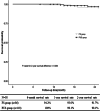Partial upper sternotomy for extensive arch repair in older acute type A aortic dissection patients
- PMID: 35313815
- PMCID: PMC8939131
- DOI: 10.1186/s12872-022-02511-1
Partial upper sternotomy for extensive arch repair in older acute type A aortic dissection patients
Abstract
Objectives: The partial upper sternotomy (PUS) approach is acceptable for aortic valve replacement, and even aortic root operation. However, the efficiency of PUS for extensive arch repair of acute type A aortic dissection (AAAD) in older adult patients has not been well investigated.
Methods: Between January 2014 and December 2019, 222 older adult patients (≥ 65 years) diagnosed with AAAD went through extensive arch repair, among which 127 received PUS, and 95 underwent full sternotomy (FS). Logistic regression analysis was used to identify risk factors for early death, and negative binomial regression analysis was applied to explore risk factors related to post-operative ventilator-supporting time and intensive care unit stay time.
Results: Total early mortality was 8.1% (18/222 patients). The PUS group had shorter Cardiopulmonary bypass time (133.0 vs.155.0 min, P < 0.001), cross-clamp time (44.0 vs. 61.0 min, P < 0.001) and shorter selective cerebral perfusion time (11.0 vs. 21.0 min, P < 0.001) than the FS group. Left ventricle ejection fraction < 50% (odds ratio [OR] 17.05; 95% confidence interval [CI] 1.87-155.63; P = 0.012) and malperfusion syndromes (OR 65.83; 95% CI 11.53-375.86; P < 0.001) were related to early death. In the multivariate model, the PUS approach contributed to shorter ventilator-supporting time (incidence rate ratio [IRR] 0.76; 95% CI 0.64-0.91; P = 0.003), when compared with the FS group.
Conclusions: The early results of emergency extensive arch repair of AAAD via PUS in older adult patients were satisfactory. However, the long-term results remain to be investigated.
Keywords: Acute type A aortic dissection; Full sternotomy; Older patients; Partial upper sternotomy.
© 2022. The Author(s).
Conflict of interest statement
The authors declare that they have no competing interests.
Figures





Similar articles
-
Surgery of ascending aorta with complex procedures for aortic dissection through upper mini-sternotomy versus conventional sternotomy.J Cardiothorac Surg. 2020 Apr 7;15(1):57. doi: 10.1186/s13019-020-01095-1. J Cardiothorac Surg. 2020. PMID: 32264907 Free PMC article.
-
Extensive repair of acute type A aortic dissection through a partial upper sternotomy and using complete stent-graft replacement of the arch.J Thorac Cardiovasc Surg. 2022 Oct;164(4):1045-1052. doi: 10.1016/j.jtcvs.2020.10.063. Epub 2020 Oct 24. J Thorac Cardiovasc Surg. 2022. PMID: 33223195
-
Minimally invasive aortic root surgery: Midterm results in a 2-year follow-up.J Card Surg. 2020 Jul;35(7):1484-1491. doi: 10.1111/jocs.14628. Epub 2020 May 22. J Card Surg. 2020. PMID: 32445199
-
Femoral cannulation is safe for type A dissection repair.Ann Thorac Surg. 2004 Oct;78(4):1285-9; discussion 1285-9. doi: 10.1016/j.athoracsur.2004.04.072. Ann Thorac Surg. 2004. PMID: 15464486 Review.
-
Minimally Invasive Versus Conventional Aortic Root Replacement - A Systematic Review and Meta-Analysis.Heart Lung Circ. 2019 Dec;28(12):1841-1851. doi: 10.1016/j.hlc.2018.10.023. Epub 2018 Nov 17. Heart Lung Circ. 2019. PMID: 30473416
References
-
- Mauduit M, Anselmi A, Tomasi J, Belhaj Soulami R, Roisné A, Flecher E, et al. Early and late outcomes of aortic surgery under hypothermic circulatory arrest in the elderly: a single center study. J Cardiovasc Surg. 2019;60(6):733–741. - PubMed
Publication types
MeSH terms
LinkOut - more resources
Full Text Sources

